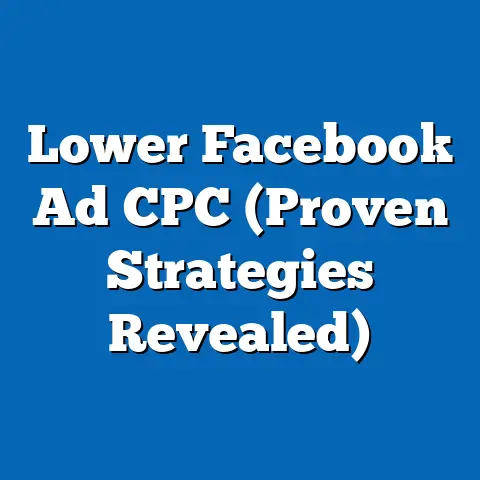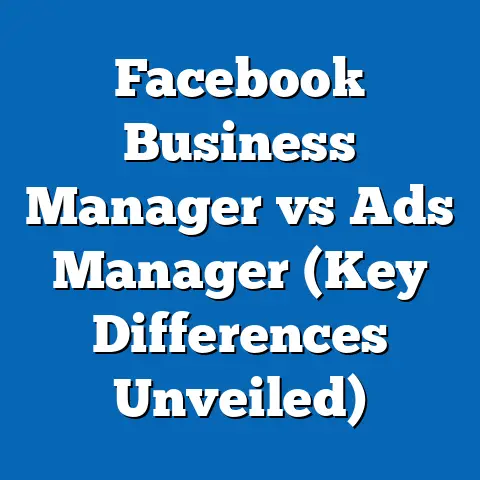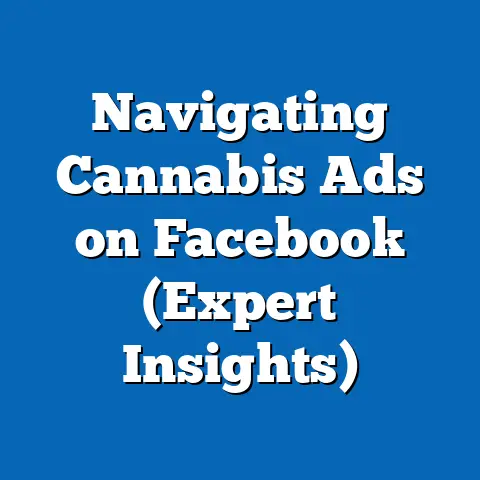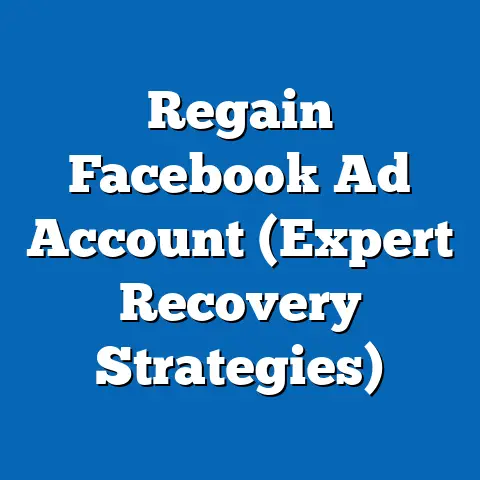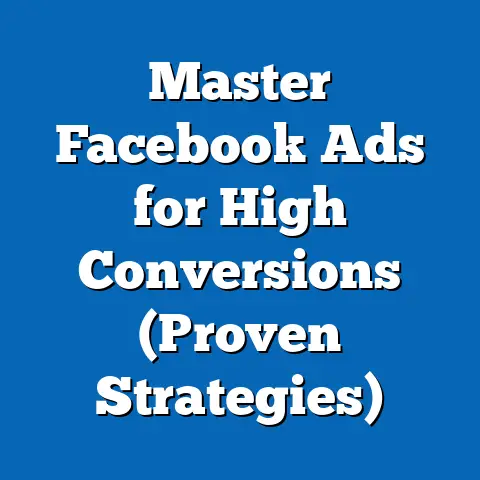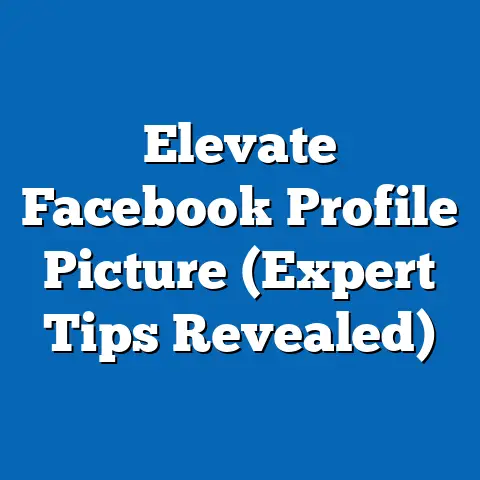Create Winning fb ad Sets in AdEspresso (Expert Guide)
Allergies. Just the word can send shivers down the spines of millions. From seasonal sniffles to life-threatening reactions, allergies affect a vast segment of the population. In fact, according to the American Academy of Allergy, Asthma & Immunology (AAAAI), over 50 million Americans experience some form of allergy each year. This translates to a massive market for allergy-related products and services, from over-the-counter medications and air purifiers to specialized allergy testing and immunotherapy treatments.
But how do you reach this target audience amidst the digital noise? That’s where the magic of Facebook advertising comes in. I’ve seen firsthand how precisely targeted Facebook ads can connect businesses with individuals actively seeking solutions to their allergy woes. However, navigating the complexities of Facebook Ads Manager can be daunting. That’s why I’m a huge advocate for tools like AdEspresso, which simplifies the ad creation and management process, making it significantly easier for marketers, especially those new to the game, to create winning ad sets.
In this expert guide, I’ll walk you through the process of crafting highly effective Facebook ad sets within AdEspresso, specifically tailored to target individuals suffering from allergies. I’ll share my personal experiences, insights, and proven strategies to help you maximize your reach, engagement, and ultimately, your return on investment. Let’s dive in!
Understanding Facebook Ads
Facebook advertising is a powerhouse. With over 2.9 billion monthly active users, Facebook offers unparalleled reach and targeting capabilities. You can pinpoint your audience based on demographics (age, location, gender), interests (hobbies, pages they like), and behaviors (purchase history, online activity). This granular targeting is what sets Facebook ads apart, allowing you to connect with the right people at the right time.
Within a Facebook ad campaign, ad sets are the control centers. They determine your budget allocation, audience targeting parameters, ad placements (where your ads appear), and schedule. Think of your campaign as the overall strategy, and your ad sets as the tactical units executing that strategy.
For niche markets like allergy-related products, Facebook ads are particularly effective. Why? Because you can target individuals who have expressed interest in allergy relief, asthma management, or specific allergy triggers like pollen or pet dander. I remember working with a local allergy clinic, and by targeting users interested in “allergy testing” and “immunotherapy,” we saw a significant increase in appointment bookings. The precision targeting made all the difference.
Key Takeaway: Facebook advertising offers unparalleled reach and precise targeting capabilities, making it ideal for reaching niche markets like allergy sufferers. Ad sets are the key to controlling your budget, audience, and placements within a campaign.
Introduction to AdEspresso
AdEspresso is a third-party tool designed to streamline and simplify the process of creating and managing Facebook ads. Think of it as your Facebook Ads Manager on steroids. It boasts a user-friendly interface, powerful features, and robust analytics that can benefit both beginners and seasoned marketers.
I’ve used AdEspresso extensively over the years, and I’ve always been impressed by its ease of use. The drag-and-drop interface makes ad creation a breeze, and the A/B testing functionality is invaluable for optimizing ad performance. It’s particularly useful for businesses in the health and wellness sector, including allergy clinics, pharmaceutical companies, and manufacturers of allergy-related products.
AdEspresso allows you to:
- Create and manage multiple ad campaigns from a single dashboard.
- A/B test different ad creatives, audiences, and placements.
- Analyze ad performance with detailed reports and visualizations.
- Automate ad optimization based on predefined rules.
- Collaborate with team members on ad campaigns.
In my experience, AdEspresso saves a significant amount of time and effort compared to using Facebook Ads Manager alone. It’s a valuable tool for anyone looking to scale their Facebook advertising efforts.
Key Takeaway: AdEspresso simplifies Facebook ad creation and management with its user-friendly interface, A/B testing capabilities, and robust analytics. It’s a valuable tool for businesses in the health and wellness sector.
Setting Up Your Ad Set in AdEspresso
Now, let’s get practical. Here’s a step-by-step guide on how to create an ad set in AdEspresso specifically targeted at individuals suffering from allergies:
Step 1: Choosing the Right Campaign Objective
Before diving into the ad set, you need to define your campaign objective. What do you want to achieve with your ads?
- Awareness: Increase brand awareness among allergy sufferers.
- Consideration: Drive traffic to your website or landing page to learn more about your products/services.
- Conversion: Generate leads or sales of allergy-related products.
For example, if you’re launching a new line of hypoallergenic bedding, you might choose the “Awareness” objective to reach a broad audience of allergy sufferers. If you’re offering a discount on allergy testing, you might choose the “Conversion” objective to drive direct sales.
Step 2: Defining Your Target Audience
This is where the magic happens. AdEspresso allows you to define your target audience with incredible precision. Here are some targeting options to consider for allergy-related products:
- Demographics: Target individuals aged 25-54 (common age range for allergy sufferers) in specific geographic locations (e.g., areas with high pollen counts).
- Interests: Target individuals interested in “allergies,” “asthma,” “hay fever,” “allergy relief,” “air purifiers,” “hypoallergenic products,” or specific allergy triggers like “pollen,” “pet dander,” or “dust mites.”
- Behaviors: Target individuals who have purchased allergy-related products online or visited websites related to allergies.
- Custom Audiences: Upload a list of your existing customers or website visitors to create a custom audience.
- Lookalike Audiences: Create a lookalike audience based on your existing customers to reach new individuals who share similar characteristics.
I once ran a campaign for an air purifier company, and by combining demographic targeting (homeowners in urban areas) with interest-based targeting (allergies, asthma, air pollution), we were able to achieve a significantly higher click-through rate (CTR) compared to previous campaigns.
Step 3: Setting Your Budget and Schedule
AdEspresso allows you to set either a daily or lifetime budget for your ad set.
- Daily Budget: The average amount you’re willing to spend each day.
- Lifetime Budget: The total amount you’re willing to spend over the entire duration of the ad set.
For beginners, I recommend starting with a daily budget of \$10-\$20 per ad set. As you gather data and optimize your ads, you can gradually increase your budget.
When setting your schedule, consider the seasonality of allergies. For example, if you’re targeting pollen allergies, you might want to run your ads during the spring and fall months.
Step 4: Selecting Ad Placements
AdEspresso allows you to choose where your ads appear on Facebook and Instagram.
- Facebook Feed: The most common placement, where ads appear directly in users’ news feeds.
- Instagram Feed: Similar to Facebook Feed, but on Instagram.
- Facebook Marketplace: Ads appear in the Facebook Marketplace.
- Facebook Right Column: Ads appear in the right column of the Facebook website (primarily on desktop).
- Instagram Explore: Ads appear in the Explore section of Instagram.
- Audience Network: Ads appear on third-party websites and apps that are part of the Facebook Audience Network.
I generally recommend starting with Facebook Feed and Instagram Feed, as these placements tend to generate the highest engagement. You can then experiment with other placements to see what works best for your target audience.
Step 5: Crafting Compelling Ad Copy and Visuals
This is where your creativity comes into play. Your ad copy and visuals need to grab the attention of allergy sufferers and resonate with their pain points.
- Ad Copy: Use clear, concise language that highlights the benefits of your product or service. Focus on solving their allergy problems. Use words like “relief,” “soothe,” “protect,” and “breathe easy.”
- Visuals: Use high-quality images or videos that depict allergy sufferers experiencing relief or enjoying life without allergies. Consider using images of nature, clean environments, or happy families.
For example, if you’re advertising an air purifier, you might use an image of a family enjoying a clean, fresh-smelling home. Your ad copy could read: “Breathe easy this allergy season with our powerful air purifier. Get relief from pollen, pet dander, and dust mites.”
Key Takeaway: Setting up your ad set in AdEspresso involves choosing the right campaign objective, defining your target audience with precision, setting your budget and schedule, selecting appropriate ad placements, and crafting compelling ad copy and visuals.
Best Practices for Creating Winning Ad Sets
Creating a successful Facebook ad set isn’t just about following the steps above. It’s also about applying best practices and continuously optimizing your ads based on performance data. Here are some proven strategies for creating winning ad sets:
A/B Testing
A/B testing, also known as split testing, is the process of comparing two versions of an ad to see which performs better. AdEspresso makes A/B testing incredibly easy. You can test different ad creatives (images, videos, headlines, ad copy), audiences, and placements.
For example, you could test two different images for your air purifier ad: one showing a family enjoying a clean home, and another showing a close-up of the air purifier itself. By tracking the performance of each ad, you can determine which image resonates better with your target audience.
Utilizing Analytics
Monitoring your ad performance is crucial for optimizing your ad sets. AdEspresso provides detailed analytics that allow you to track key metrics such as:
- Reach: The number of unique individuals who saw your ad.
- Impressions: The number of times your ad was displayed.
- Click-Through Rate (CTR): The percentage of people who clicked on your ad.
- Cost-Per-Click (CPC): The average cost you paid for each click on your ad.
- Conversion Rate: The percentage of people who completed a desired action (e.g., made a purchase, filled out a form).
- Cost-Per-Acquisition (CPA): The average cost you paid for each conversion.
By analyzing these metrics, you can identify areas for improvement. For example, if your CTR is low, you might need to revise your ad copy or visuals. If your CPA is high, you might need to refine your targeting or landing page.
Retargeting
Retargeting is the process of showing ads to individuals who have previously interacted with your website or Facebook page. This is a highly effective strategy for reaching individuals who are already interested in your products or services.
For example, you could retarget individuals who visited your website but didn’t make a purchase. You could show them an ad with a special discount or offer to encourage them to complete their purchase.
Ad Creative Tips
When creating ad creatives for allergy-related products, keep these tips in mind:
- Focus on the benefits: Highlight how your product or service can alleviate allergy symptoms and improve quality of life.
- Use relatable imagery: Show people experiencing relief or enjoying activities without allergies.
- Address common pain points: Acknowledge the challenges that allergy sufferers face and offer solutions.
- Use social proof: Include testimonials or reviews from satisfied customers.
- Create a sense of urgency: Use limited-time offers or discounts to encourage immediate action.
I’ve found that using user-generated content (UGC) in ads can be incredibly effective. Showing real people using and benefiting from your product builds trust and credibility.
Key Takeaway: Best practices for creating winning ad sets include A/B testing, utilizing analytics, retargeting, and following ad creative tips. Continuous optimization based on performance data is essential.
Troubleshooting Common Issues
Even with the best strategies, you might encounter challenges when creating Facebook ad sets. Here are some common pitfalls and solutions:
- Low Engagement Rates: This could be due to irrelevant targeting, uncompelling ad creatives, or poor ad placement. Refine your targeting, experiment with different ad creatives, and test different placements.
- High Cost-Per-Click (CPC): This could be due to a competitive market, poor ad quality, or irrelevant targeting. Improve your ad quality score, refine your targeting, and consider bidding strategies.
- Difficulty in Targeting the Right Audience: This could be due to limited data or inaccurate targeting parameters. Utilize custom audiences and lookalike audiences to reach a more targeted audience.
- Ad Fatigue: This occurs when your audience becomes tired of seeing the same ads. Refresh your ad creatives regularly and experiment with different ad formats.
Remember, continuous learning and adapting your ad strategies based on performance data is crucial for success. Facebook’s advertising landscape is constantly evolving, so staying up-to-date with the latest trends and best practices is essential.
Key Takeaway: Common issues when creating Facebook ad sets include low engagement rates, high cost-per-click, difficulty in targeting the right audience, and ad fatigue. Continuous learning and adaptation are crucial for success.
Conclusion
Creating winning Facebook ad sets in AdEspresso requires a combination of strategic planning, creative execution, and continuous optimization. By understanding the power of Facebook advertising, leveraging the features of AdEspresso, and applying the best practices outlined in this guide, you can significantly enhance your marketing efforts, particularly for allergy-related products.
Remember, the potential for businesses to make a positive impact on the lives of those suffering from allergies through effective advertising is immense. By reaching the right people with the right message at the right time, you can help them find relief, improve their quality of life, and ultimately, build a loyal customer base.
So, go forth and create some winning ad sets! Experiment, analyze, and adapt. The world of Facebook advertising is constantly evolving, and the opportunities for growth are endless. I’m confident that with the knowledge and strategies shared in this guide, you’ll be well on your way to achieving your marketing goals and making a real difference in the lives of allergy sufferers. Good luck!

